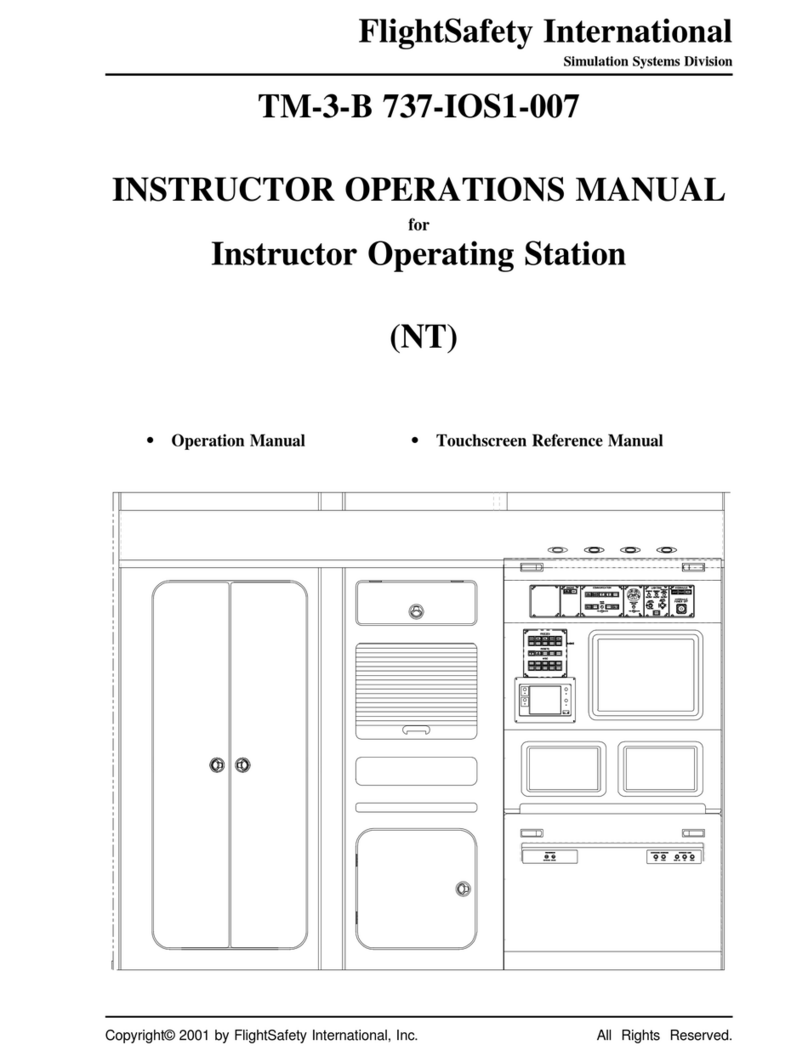FlightSafety BARON G8 Installation guide

“The best safety device in any aircraft is a well-trained crew.”™
BARON G58
PILOT TRAINING MANUAL
REVISION 0.2
FlightSafety International, Inc.
Marine Air Terminal, LaGuardia Airport
Flushing, New York 11371
(718) 565-4100
www.FlightSafety.com
BARON G58
PILOT
TRAINING
MANUAL
REVISION 0.2

FOR TRAINING PURPOSES ONLY
FOR TRAINING PURPOSES ONLY
NOTICE
The material contained in this training manual is based on information obtained from the aircraft
manufacturer’s Airplane Flight Manual, Pilot Manual, and Maintenance Manuals. It is to be used for
familiarization and training purposes only.
At the time of printing it contained then-current information. In the event of conict between data
provided herein and that in publications issued by the manufacturer or the FAA, that of the manu-
facturer or the FAA shall take precedence.
We at FlightSafety want you to have the best training possible. We welcome any suggestions you
might have for improving this manual or any other aspect of our training program.

Courses for the Baron G58 are taught at the following FlightSafety learning center:
Wichita (Hawker Beechcraft) Learning Center
9720 East Central Avenue
Wichita, Kansas 67206
Phone: (316) 612-5300
Toll-Free: (800) 488-3747
Fax: (316) 612-5399
Copyright © 2012 by FlightSafety International, Inc.
All rights reserved.
Printed in the United States of America.

INSERT LATEST REVISED PAGES, DESTROY SUPERSEDED PAGES
LIST OF EFFECTIVE PAGES
Dates of issue for original and changed pages are:
Original ...........0......... May 2007
Revision........ 0.1........ August 2011
Revision........ 0.2........ June 2013
NOTE:
For printing purposes, revision numbers in footers occur at the bottom of every page that has
changed in any way (grammatical or typographical revisions, reow of pages, and other changes
that do not necessarily affect the meaning of the manual).
THIS PUBLICATION CONSISTS OF THE FOLLOWING:
(Continued on next page)
Cover....................................................... 0.1
i—vi.......................................................... 0.1
1-i—1-iv...................................................... 0
1-1—1-3 .................................................. 0.1
1-4—1-10 ................................................... 0
2-i—2-iv...................................................... 0
2–1........................................................... 0.1
2–2—2-5..................................................... 0
2-6 ........................................................... 0.1
2-7 .............................................................. 0
2-8 ........................................................... 0.1
2-9—2-10 ................................................... 0
3-i—3-iv...................................................... 0
3-1—3-4 .................................................. 0.1
3-5—3-6 ..................................................... 0
4-i—4-ii....................................................... 0
4-iii—4-iv ................................................. 0.1
4-1—4-3 .................................................. 0.1
4-4 .............................................................. 0
5-i—5-iv...................................................... 0
5-1—5-2 .................................................. 0.1
5-3 .............................................................. 0
5-4—5-6 .................................................. 0.1
5-7—5-8 ..................................................... 0
6-i—6-ii.................................................... 0.1
7-i—7-ii....................................................... 0
7-iii—7-iv ................................................. 0.1
7–1........................................................... 0.1
7-2—7-7 ..................................................... 0
7-8 ........................................................... 0.1
7-9—7-16 ................................................... 0
7-17 ......................................................... 0.1
7-18—7-20 ................................................. 0
8-i—8-iv...................................................... 0
8-1 ........................................................... 0.1
8-2—8-4 ..................................................... 0
9-i—9-iv...................................................... 0
9-1 ........................................................... 0.1
9-2 .............................................................. 0
9-3 ........................................................... 0.1
9-4 .............................................................. 0
10-i—10-iv.................................................. 0
10-1 ......................................................... 0.1
10-2—10-8 ................................................. 0
11-i—11-iv.................................................. 0
11-1 ......................................................... 0.1
11-2—11-4 ................................................. 0
11-5 ......................................................... 0.1
11-6—11-8 ................................................. 0
11A-i—11A-iv ............................................ 0.2
11A1—11A-8........................................... 0.2
12-i—12-ii................................................ 0.1
13-i—13-ii................................................ 0.1
14-i—14-iv.................................................. 0
Page *Revision
No. No.
Page *Revision
No. No.

*Zero in this column indicates an original page.
14-1 ......................................................... 0.1
14-2—14-10 ............................................... 0
15-i—15-iv.................................................. 0
15-1 ......................................................... 0.1
15-2—15-8 ................................................. 0
16-i—16-iv............................................... 0.1
16-1 ......................................................... 0.1
16-2—16-3 ................................................. 0
16-4 ......................................................... 0.1
16-5—16-7 ................................................. 0
16-8—16-14 ............................................ 0.1
17-i—17-ii................................................ 0.1
18-i—18-iv.................................................. 0
18-1 ......................................................... 0.1
18-2—18-8 ................................................. 0
APP A-i—APP A-iv .................................. 0.1
APP A-1—APP A-32 ............................... 0.1
APP B-1—APP B-2 ................................. 0.1
Page *Revision
No. No.
Page *Revision
No. No.
Table of contents
Other FlightSafety Aircraft manuals



















